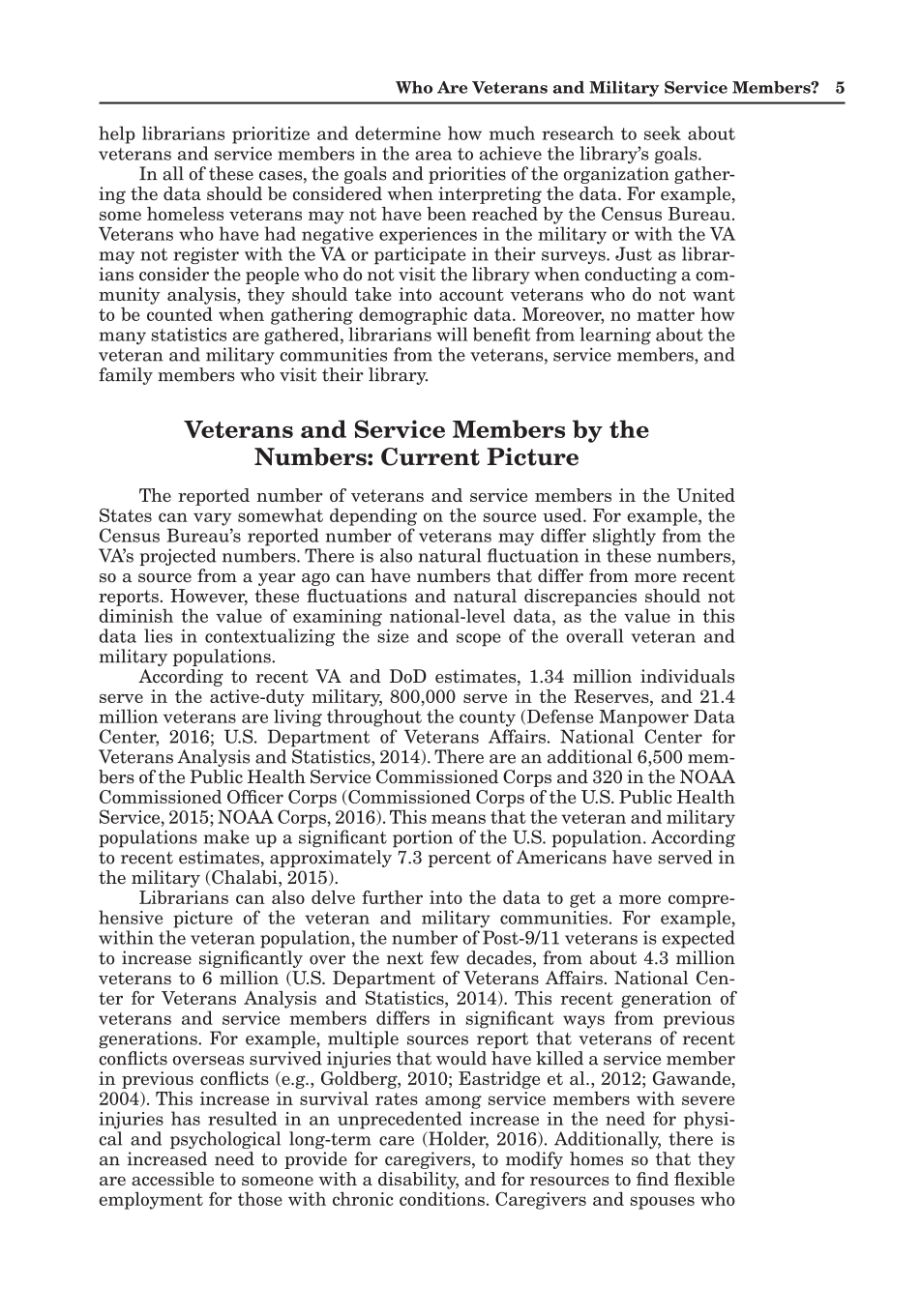Who Are Veterans and Military Service Members? 5
help librarians prioritize and determine how much research to seek about
veterans and service members in the area to achieve the library’s goals.
In all of these cases, the goals and priorities of the organization gather-
ing the data should be considered when interpreting the data. For example,
some homeless veterans may not have been reached by the Census Bureau.
Veterans who have had negative experiences in the military or with the VA
may not register with the VA or participate in their surveys. Just as librar-
ians consider the people who do not visit the library when conducting a com-
munity analysis, they should take into account veterans who do not want
to be counted when gathering demographic data. Moreover, no matter how
many statistics are gathered, librarians will benefit from learning about the
veteran and military communities from the veterans, service members, and
family members who visit their library.
Veterans and Service Members by the
Numbers: Current Picture
The reported number of veterans and service members in the United
States can vary somewhat depending on the source used. For example, the
Census Bureau’s reported number of veterans may differ slightly from the
VA’s projected numbers. There is also natural fluctuation in these numbers,
so a source from a year ago can have numbers that differ from more recent
reports. However, these fluctuations and natural discrepancies should not
diminish the value of examining national-level data, as the value in this
data lies in contextualizing the size and scope of the overall veteran and
military populations.
According to recent VA and DoD estimates, 1.34 million individuals
serve in the active-duty military, 800,000 serve in the Reserves, and 21.4
million veterans are living throughout the county (Defense Manpower Data
Center, 2016; U.S. Department of Veterans Affairs. National Center for
Veterans Analysis and Statistics, 2014). There are an additional 6,500 mem-
bers of the Public Health Service Commissioned Corps and 320 in the NOAA
Commissioned Officer Corps (Commissioned Corps of the U.S. Public Health
Service, 2015; NOAA Corps, 2016). This means that the veteran and military
populations make up a significant portion of the U.S. population. According
to recent estimates, approximately 7.3 percent of Americans have served in
the military (Chalabi, 2015).
Librarians can also delve further into the data to get a more compre-
hensive picture of the veteran and military communities. For example,
within the veteran population, the number of Post-9/11 veterans is expected
to increase significantly over the next few decades, from about 4.3 million
veterans to 6 million (U.S. Department of Veterans Affairs. National Cen-
ter for Veterans Analysis and Statistics, 2014). This recent generation of
veterans and service members differs in significant ways from previous
generations. For example, multiple sources report that veterans of recent
conflicts overseas survived injuries that would have killed a service member
in previous conflicts (e.g., Goldberg, 2010; Eastridge et al., 2012; Gawande,
2004). This increase in survival rates among service members with severe
injuries has resulted in an unprecedented increase in the need for physi-
cal and psychological long-term care (Holder, 2016). Additionally, there is
an increased need to provide for caregivers, to modify homes so that they
are accessible to someone with a disability, and for resources to find flexible
employment for those with chronic conditions. Caregivers and spouses who








































































































































































































